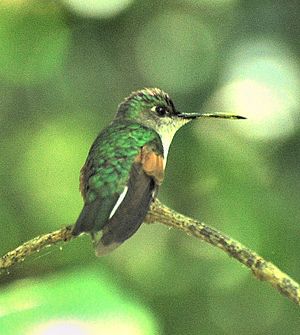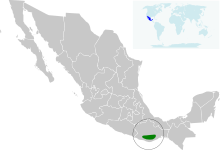Blue-headed hummingbird
| Blue-headed hummingbird | ||||||||||||
|---|---|---|---|---|---|---|---|---|---|---|---|---|

Blue-headed hummingbird ♀ |
||||||||||||
| Systematics | ||||||||||||
|
||||||||||||
| Scientific name | ||||||||||||
| Eupherusa cyanophrys | ||||||||||||
| Rowley & Orr , 1964 |
The blue-headed hummingbird or blue- headed hummingbird ( Eupherusa cyanophrys ) is a species of bird in the hummingbird family (Trochilidae) that is endemic to Mexico . The stock is, according to IUCN endangered ( Endangered ). The species is considered to be monotypical .
features
The blue-headed hummingbird reaches a body length of about 10 to 11 cm, with a weight of 4.5 to 5.2 g. The male has a straight black beak. The plumage is almost completely green, with the underside more glittering. The front skull is violet-blue, the back is turquoise. The under tail-coverts are white, the wings dark with red-brown arm-wings. The red-brown arm wings stand out from the dark wings. The central pair of control feathers of the slightly rounded tail are green, the rest are white. It differs from the allopatric white-tailed hummingbird only in the color of the front skull. The female has a green top and a white spot behind the eye. The ear covers are dark gray. The underside is light gray, the arm wings are less reddish brown in color. The tail resembles that of the male, but the white outer tail feathers have dark green edges. Young animals resemble the females, with the male young animals having a dull green underside. The very similar beryl lamazily ( Amazilia beryllina ( Deppe , 1830)) differs through the red-brown tail, the missing blue upper head and the red lower bill.
Behavior and nutrition
The blue-headed hummingbird gets its nectar a . a. of plants of the genera Inga , Kohleria , Lobelia , Malvaviscus , Manettia , Psittacanthus and Hamelia . When eating, he arranges other hummingbirds z. B. the genus of Amazilia hummingbirds . He gets his food in all strategies .
Reproduction
The breeding season of the blue-headed hummingbird is September to November and May. The goblet-shaped nest is made of moss and is covered with plant waste. The outside is decorated with lichen. Sage flowers were used to build two nests that were discovered . He places the nest in branches in smaller trees 1.2 to 6 meters above the ground. The nest, discovered at a height of six meters, may be an exception, as it was discovered on a steep slope by a road where exposed branches of a pine protruded into the road. A clutch consists of two eggs that are only incubated by the female.
Vocalizations
The singing consists of a bright, fast, fluid and squeaky trill. This takes 2 to 8 seconds. It also emits a liquid, humming, rolling chirp that often turns into a rattling trill. This is reminiscent of the sounds of the striped- tailed hummingbird ( Eupherusa eximia ( Delattre , 1843)). This is similar to the white tailed hummingbird, but the song is less jerky and less rushed.
distribution and habitat
The blue-headed hummingbird prefers open spots through fallen trees and forest edges of moist evergreen forests with dense undergrowth mostly of the genus Chusquea , semi -natural deciduous forests, gallery forests and cloud and cloud forests at altitudes between 700 and 2600 meters. Most often it occurs at altitudes between 1300 and 1800 meters.
migration
The blue-headed hummingbird is usually considered a resident bird . It is believed that it occasionally migrates between high altitudes as a line bird .
Etymology and history of research
The blue-headed hummingbird was first described in 1964 by John Stuart Rowley Jr and Robert Thomas Orr under the scientific name Eupherusa cyanophrys . The type specimen was collected by Rowley on May 9, 1963 south of San Pedro Juchatengo . It was John Gould who introduced the new genus Eupherusa in 1857 . The word “Eupherusa” is derived from the Greek words “eu εὖ ” for “good” and “pherō φέρω ” for “to wear”. The species name "cyanophrys" derives from "cyanophrus, cyanophruos κυανοφρυς, κυανοφρυος " for "dark brauig" and is a Greek word structure of "cyanos κυανος " for "Dark Blue" and "ophrus, ophruos οφρυς, οφρυος " for "eyebrow eyebrow «.
literature
- Thomas Züchner, Peter Boesman in: Josep del Hoyo , Andrew Elliott, Jordi Sargatal , David Andrew Christie , Eduardo de Juana: Oaxaca Hummingbird (Eupherusa cyanophrys) In: Handbook of the Birds of the World Alive . Lynx Edicions, Barcelona.
- James A. Jobling: Helm Dictionary of Scientific Bird Names . Christopher Helm, London 2010, ISBN 978-1-4081-2501-4 .
- John Stuart Rowley, Robert Thomas Orr: A New Hummingbird from Southern Mexico . In: The Condor . tape 66 , no. 2 , 1964, p. 81–84 (English, sora.unm.edu [PDF; 241 kB ]).
- John Gould: A monograph of the Trochilidæ, or family of humming-birds . tape 5 , delivery 14. Taylor and Francis, London 1857 ( biodiversitylibrary.org ).
- Frederick Herschel Waterhouse: The dates of publication of some of the zoological works of the late John Gould, FRS RH Porter, London 1885 ( biodiversitylibrary.org ).
Web links
- Eupherusa cyanophrys in the endangered Red List species the IUCN 2019.1. Listed by: BirdLife International, 2016. Retrieved June 30, 2019.
- BirdLife International: Species Factsheet - Oaxaca Hummingbird ( Eupherusa cyanophrys ) . Retrieved June 30, 2019.
- Videos, photos and sound recordings for Oaxaca Hummingbird (Eupherusa cyanophrys) in the Internet Bird Collection
- Blue- headed hummingbird ( Eupherusa cyanophrys ) at Avibase; accessed on June 30, 2019.
- Eupherusa cyanophrys in the Integrated Taxonomic Information System (ITIS). Retrieved June 30, 2019.
- xeno-canto: sound recordings - blue- headed hummingbird ( Eupherusa cyanophrys )
- Oaxaca Hummingbird (Eupherusa cyanophrys) in the Encyclopedia of Life . Retrieved June 30, 2019.
Individual evidence
Remarks
- ↑ According to Frederick Herschel Waterhouse p. 49, Plate 324 appeared as part of Delivery 14 from 1857. Here Gould assigned the striped- tailed hummingbird ( Eupherusa eximia ) to the genus.
